
Color is an intimate part of our lives. It affects and reflects us all. It is used to describe our physical health, our moods, our attitudes, and even our spiritual experiences. Listen to people speak and notice how often color is used as a part of their descriptive vocabulary.
“I’m in the pink today.”
“He was so angry he turned red.”
“She was feeling a little blue.”
“They are just green with envy.”
“Oh, he has a yellow streak down his back.”
“It was a golden experience.”
Color is a property of light. When light is broken down into different wavelengths, we end up with different colors. It is like holding a prism up to the sunlight. It will display a rainbow on an opposite surface. Those seven colors of the rainbow are only a small fraction of the light spectrum, since the spectrum contains a multitude of shades and variances of each color.
The energy of an aura reflects itself in light and color. The color, its clarity, and its location all indicate different things about a person’s physical, emotional, mental, and spiritual well-being. As you work with the exercises in this book, you will begin to visibly detect the colors of the aura. Until then, you can use the dowsing rods and pendulums to help you identify the colors of the aura. Determining the colors is the easy part. The difficult part is understanding and interpreting those colors.
We are all sensitive to color. We are also sensitive to what it may reflect. We just have not given it much conscious attention. We have all had experiences where we wondered about a friend because his or her “color” was a bit off. We have also heard comments about how the color of a blouse or shirt is wonderful for someone or washes the person out. Many times these comments reflect unconscious impressions of auras. They just have not registered as such.
Different colors reflect different attitudes, moods, and energy patterns. Although you can identify generally what certain colors reflect, you must keep in mind that there
are a multitude of shades within a particular color’s spectrum. There are many shades of yellow, green, etc. Understanding the significance of those shades takes time and practice.
In determining the colors within the aura, there are certain guidelines to keep in mind:
1. Those colors closest to the physical body usually reflect physical conditions and energies. The outer colors reflect emotional, mental, and spiritual energies that can be affecting those physical colors.
2. The clearer and more pastel the colors, the better. Muddier and thicker colors can reflect imbalances, overactivity, and other possible problems in the area to which the colors are connected.
3. Dark colors that are also bright can indicate high energy levels. This is not necessarily negative. You do not want to jump to conclusions.
4. There is often more than one color in the aura. Each color will reflect different aspects. You must learn how these different colors interact and what kind of effect that combination can have. Again, that takes time and practice.
5. When you start seeing other people’s auras, keep in mind that you are looking at them through your own aura. To interpret what you are seeing, you need to be aware of your own aura. Using the earlier eye exercises can assist you in seeing your own aura within a mirror. If your aura is predominantly yellow and the other person’s is blue, you may actually see green. Yellow and blue combined make green. Often the subconscious mind is aware of this and makes that adjustment naturally, but you must be careful about jumping to conclusions.
6. It is important not to make judgments of people based on what you see in their auras. What you see and how you interpret it depends a great deal on your state of mind at the time. Consider the pros and cons of what is associated with that color, along with specific areas to which it is connected. You do not have the right to tell someone else what to do. Bring up the observations, explain possible significances, and then let the other person make his or her own decisions and choices.
7. Learn to use your own intuition in interpreting. Ask the individual questions about what you are observing and what you think it might relate to. Only in this way, through the other person’s feedback, can you develop criteria for your interpretations. Remember that the color, the location, and the clarity can all indicate different things. Your task is to learn to synthesize them.
8. Auras change frequently. The colors closest to the body (extending out about a foot to two) can go through many changes in a single day. Every strong emotion and every strong physical or mental activity can result in color and light fluctuations in the aura. Our auras change as we go through life as well. As you develop the ability to see the aura, you will find that an individual has a predominant color or colors that remain consistently within their auric field (although there may be shade variations). What are the secondary colors, and what is their relationship to the primary tones?
9. Usually the first color or shades to appear are shades of gray and light blue. Do not be discouraged, however, if the colors do not become readily apparent. As you work with the exercises, this will change. Usually in the beginning people are very persistent, but they also expect results within a certain time frame. If the results do not occur quickly enough or strongly enough within that time period, they become discouraged.
Set no time limits on yourself. Use the exercises every day. Only by exercising and stretching your perceptions every day do you open to effective results. Performing them two or three days in a row, then skipping a week, and then going back to them will not bring results. You must be consistent. If you are, you will have some visual success within four to six weeks.
At the very least, you will begin to see the aura, even if no colors become visible. Most people with whom I have worked begin to achieve
excellent results within one to six months, but it only takes a month to confirm that the process works!
10. As you begin to develop your auric vision, you will begin to see auras around everyone and everything. This can be distracting. The exercises in this book are designed to help you develop the ability to turn your auric vision on and off at will. Remember that you do not have the right to be tuning into other’s energies without their permission. In many cases, it is like reading their mail. Even if you do perceive something, you do not have the right to reveal it unless you are invited to do so. Use your vision responsibly.
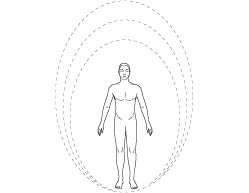
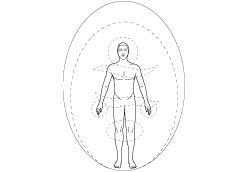
The Appearance of Colors in the Aura
Colors may take different forms, shades, and positions around the body (figure B) or they may reflect themselves in softly blending bands of color (figure A).
The Meaning of Colors
Color can be constructive or destructive. It can stimulate or depress, repel or attract. It can even be male or female in its character. It can reflect positive or negative energy, and when perceived within the aura, it provides a key to the personality, moods, maturity, and health of the individual. Aura color reflects both physical and spiritual
aspects.
It takes a great deal of practice to interpret the color shades seen within the aura. Each color has its general characteristic, but each shade of that color changes that characteristic a little. The location of the color, the
intensity, and even the form the color takes within the auric field must be considered.
This text is not intended to provide all of the subtle nuances of color interpretation within the auric field. You will examine basic colors and the energies they commonly indicate on physical and other levels. This gives you a starting point to understand what is revealed by the colors of the aura.
The colors closest to the body reflect aspects of the individual’s physical condition. They also indicate those energies manifesting and pressing most currently within his or her life. The colors and energies further away often indicate the energy that the person will be moving into within his or her life. With practice, you will be able to determine time elements of certain energy patterns by the color and the location of the color with respect to the physical body.
The Rainbow Colors
Red
Red is the color of strong energy, fire, and primal creative force. It is the life-promoting energy. It is hot. It can indicate strong passion, mind, and will. It is a dynamic color that can reflect anger, love, hate, and unexpected changes. It can indicate new birth and transmutation.
It is a color that affects the circulatory system of the body, the reproductive system (sexual energy), and an awakening of latent abilities and talents.
Too much red or a muddiness can reflect overstimulation, inflammation, or imbalance. It may reflect nervousness, temper, aggression, impulsiveness, or excitement.
Orange
Orange is the color of warmth, creativity, and emotions. It is an indication of courage, joy, and socialness. It is a color that can reflect an opening of new awareness—especially to the subtle realms (the astral plane) of life.
Depending on the shade, it can also indicate emotional imbalance and agitation. Some of the muddier shades of orange can reflect pride and flamboyance. It may reflect worry and vanity.
Yellow
Yellow is one of the first and the easiest aura colors to be seen. Pale yellow around the hairline can indicate optimism; yellow is the color of mental activity and new sunshine. It can reflect new learning opportunities, lightness, wisdom, and intellect. The more pastel shades often reflect an enthusiasm for something in life, the power of ideas, and spiritual development (especially in the pale yellow to white spectrum). Yellow is a color that represents the power of ideas, awakening psychic abilities, and clairsentience.
Deeper and muddier shades of yellow can reflect excessive thinking and analyzing. It can reflect being overly critical, feelings of being deprived of recognition, and being dogmatic.
Green
Green is the color of sensitivity and growing compassion. It reflects growth, sympathy, and calm. It can reflect a person who is reliable, dependable, and open-minded. Bright greens moving toward the blue spectrum in the aura indicate healing ability. It is a color of abundance, strength, and friendliness.
The muddier or darker shades of green can reflect uncertainty and miserliness. The muddier shades often reflect jealousy and possessiveness as well. It can indicate self-doubt and mistrust.
Blue
Blue, next to yellow, is one of the easiest colors to see in the aura. It is the color of calm and quietness. It reflects devotion, truth, and seriousness. It can indicate the ability for clairaudience and for the development of telepathy.
The lighter shades of blue reflect an active imagination and good intuition. The deeper shades of blue can indicate a sense of loneliness, which on one level reflects a life-long quest for the divine. The deeper shades of blue reflect levels of devotion. Royal blue shades indicate honesty and good judgment. They can also indicate the person has found or is about to find his or her chosen work.
The muddier shades of blue can reflect blocked perceptions. They can indicate melancholy, rushing and worrying, domineering, fearfulness, forgetfulness, and oversensitivity.
Violet and Purple
Violet is the color of warmth and transmutation. It is the color for the blending of the heart and the mind, the physical with the spiritual. It reflects independence and intuition, as well as dynamic and important dream activity. It can reflect one who is searching. The purple shades often reflect an ability to handle affairs with practicality and worldliness. The paler and lighter shades of violet and purple can reflect humility and spirituality. The red-purple shades can indicate great passion or strength of will. They may also reflect a need for greater individual effort.
The darker and muddier shades can reflect a need to overcome something. They can also reflect intense erotic imaginations as well. Tendencies toward being overbearing, needing sympathy, and feeling misunderstood are also reflected in muddier shades.
Other Colors of the Aura
Pink
Pink is a color of compassion, love, and purity. It can reflect joy and comfort and a strong sense of companionship. When seen in the aura, it can indicate the quiet, modest type of individual, along with a love of art and beauty.
Depending on the shade of pink, it can also reflect an immaturity, especially the muddier shades. It can reflect truthfulness or a lack of it. It can also reflect times of new love and new vision.
Gold
Gold is a color that reflects dynamic spiritual energy and a true coming into one’s own power. It expresses the higher energies of devotion and a restoration of harmony. It shows strong enthusiasm and great inspiration. It indicates a time of revitalizing.
Muddier shades of gold can indicate the person is still in the process of awakening higher inspiration and has not clarified it yet within his or her life. It reflects the alchemical process still being active; the person is still working to turn the lead of his or her life into gold.
White
White is often seen in the aura, prior to any actual colors. It is often seen as a diaphanous shade. White has all colors within it, and when it does appear strongly within the aura, it is often in conjunction with other colors. This is how you can know whether it is an actual energy color or just a poor perception of the aura. When the white does stand out as a color in the aura, it reflects truth and purity. It indicates that the energy of the individual is cleansing and purifying itself. It often reflects an awakening of greater creativity as well.
Gray
Gray is a color of initiation. It can indicate a movement toward unveiling innate abilities. Those shades of gray that lean more toward the silver reflect an awakening of the feminine energies. These are the energies and abilities of illumination, intuition, and creative imagination.
The darker shades of gray can indicate physical imbalances, especially if seen next to specific areas of the physical body. They can also indicate a need to leave no task undone. Much gray in the aura can indicate a person who is secretive and who is the lone wolf type.
Brown
Brown often appears in the auric field. Although many people think of it as reflecting a lack of energy or an imbalance, this is not always so. Brown is the color of the earth. When it shows itself in the aura, especially in areas above the head and around the feet, it can reflect new growth. It indicates establishing new roots and a desire to accomplish. It is a color that can reflect industry and organization.
On the other hand, brown across the face or touching the head may indicate a lack of and need for discrimination. If seen in the areas of the chakras, it can indicate that those centers need to be cleaned. It will reflect, in such cases, a clogging of their energies. Brown is often difficult to interpret, as it can easily reflect problem areas in the physical, but you must be careful about jumping to conclusions when you see it. Feedback from the other person is the best means of understanding it.
Black
Black is one of the most confusing of colors in the auric spectrum. I have heard individuals say that, when black shows up in the aura, it is an indication of death or terrible disease. I have not found that to be true.
Black is a color of protection. It is a color that can shield an individual from outside energies. When seen in the aura, it can reflect that the person is protecting himself or herself. It can also indicate that the person has secrets. There is nothing wrong with that, as long as it is not taken to extremes. Black can also indicate that a new understanding of burdens and sacrifices is going to manifest.
Black can also indicate imbalances. Physical imbalances often show up as black or darkened areas in the aura around the physical body. The location provides clues to this. In the outer edges of the aura, black can indicate holes in the auric field. I have seen this in the auras of those who were victims of child abuse*[1] and those who are or were strong substance abusers (alcohol, drugs, tobacco, etc.).
Silver Twinklies
Another aspect that I have observed should be mentioned. I have often seen within the aura what look to be soft, twinkling lights. They are usually very sparkly and silver in color. I have found that they indicate one of several things. These “twinklies,” as I call them, are almost always a sign of great creativity and fertility. When they appear within the auric field of a person, it indicates that greater creativity is being activated within the individual’s life.
I have seen these most frequently around women, but they are not confined solely to them. When I do see them around a woman whose aura I am reading, I will ask her if she is pregnant. These twinklies are always present around pregnant women and women who have delivered a child within the past six to nine months. You must remember, though, that not everyone that has the twinklies is pregnant, even though most pregnant women have them in the aura.
My own theory is that these twinkling lights indicate the activation of creativity and fertility within the individual’s life. That creativity and fertility, however, can take a number of forms. They do not have to represent pregnancy. My own theory, however, is that when this creativity becomes so active that it shows up as lights in the auric field, it draws new souls close to that individual. Then, if the opportunity arises, they “slip in.”
If the person I am reading is not pregnant when I have observed these twinklies, I will caution her to be extra careful over the next six to nine months, as there is a greater likelihood for pregnancy to occur. Forewarned is forearmed, so to speak.
If the fertility does not culminate with a physical pregnancy, then it will play itself out in another area of the individual’s life. Usually within nine months, ten at the outside, something will be born into the person’s life that ultimately will be as life-changing as a new child. A positive, beneficial door will open for the individual. It may take as long as six months for events to play themselves out fully, but once the creative opportunity arrives, it is usually very dynamic and very positive.
As you develop your auric sight, you will become aware of the subtle differences in aura color. A study of chromotherapy and color will assist you not only in becoming more sensitive to aura color, but also in understanding its significance.
Determining Primary Colors of the Aura
Until you develop the ability to see the colors of the aura, you can still determine the primary ones through radiesthesia. You can use your dowsing rods or your pendulum. Remember that the subconscious is already aware of the energies of the aura; you just have not been able to consciously and visibly perceive them. The dowsing rods and pendulum help you extract those subconscious perceptions and bring them out into your conscious awareness.
You can use the charts on pages 110 to 112 to assist you with this.
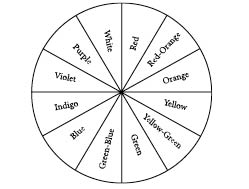
Sample Color Wheel for Dowsing the Aura
1. If you are going to use the dowsing rods, construct a circular chart similar to that at the top of page 110. Draw the chart on a sheet of plain white paper, at least one foot in diameter. Instead of writing the names of the colors on the chart, you may wish to color in each section of the chart itself. If you choose to use the pendulum, draw the sample chart found at the bottom of page 110. Color in the squares for the colors.
2. Take a moment to relax and place both feet flat on the floor. Rest your elbows on the flat surface upon which lays the chart. For the dowsing rod determination, you will only use one of the rods. Hold the rod far enough away from you so that the tip of the rod will not touch any part of you. It should be free to swing in a complete circle. Hold the rod lightly so that your hand is above the center of the circle. At this point, focus on the person whose aura you are reading or upon yourself. If you are reading your own aura, close your eyes and think about yourself.
3. At this point, ask yourself some questions. Do this at least mentally, but you may also wish to do it out loud, “What is the primary color of _____’s aura?” Pause and allow the rod to swing and point out the area of the chart that most depicts the color. You may also wish to ask questions about secondary colors, “What is the next most important color in ____’s aura?” If the rod points to an area between two colors, reflect upon the significance of both. Remember, there are many shades of color, and they might not all be depicted upon the chart. You may have to use the question, “What color is closest to the color of ____’s aura?”
4. For the chart with the pendulum, the process is the same. Rest your elbow on the flat surface so that the pendulum hangs three to six inches over the chart of colors as depicted on page 116. Start at one end of the chart, and work your way through all of the colors.
You will use yes and no responses of the pendulum to determine the auric colors. Again, ask your questions, “Is red a part of ____’s aura?”, “Is red the primary color of ____’s aura?”, etc. Pay attention to how the pendulum responds. Let it give you its yes or no answers. Also, pay attention to how strongly it responds. The stronger it answers, the stronger that color may be in the aura.
5. Go through each color on the chart with your pendulum. Again, remember you must phrase the question so it can be answered with a yes or no response. You can even use this to help you locate where these colors are in the aura.
• “Is this red primarily above the head?”
• “Is this green indicating something about the physical body?”
• “Is the blue a dark blue?”
• “Is the yellow located above the head in the aura?”
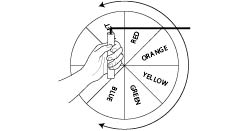
Using the Dowsing Rods to Determine the Color of the Aura
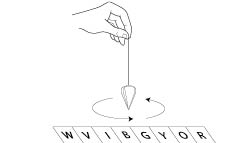
Using the Pendulum to Determine the Color of the Aura
Do not be afraid to experiment. The more you use these tools, the more you become consciously aware that your energies extend beyond physical boundaries. You enhance your perception and break down barriers that can hinder your actual physical senses.

Sample Color Chart for Using the Pendulum
to Determine Aura Colors
Seeing and Interpreting the Health Aura
When you begin to see the aura, it is usually the area closest to the physical body. This particular area reflects the physical health of the individual to a great degree. In a healthy person, the energy of the physical body appears in the aura as radiant lines of energy. This energy can be of various colors, but it often appears, not like a cloud enveloping the body, but rather more like streams of energy radiating outward from it (refer to the diagram on the next page). The colors often stand out against the backdrop of the entire auric field.
The appearance of this radiation tells much about the health of the individual. The stronger, more balanced, and symmetrical the radiations, the stronger and healthier the individual will be. If there is a lack of symmetry in the radiant lines of energy, then it indicates a weakness, imbalance, or disease somewhere within the physical body. The areas of asymmetrical streams can provide clues to the part of the body that is having problems.
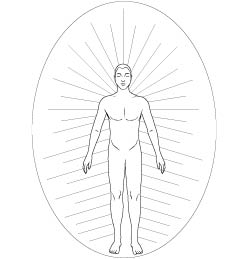
Radiant Lines of Energy
In a healthy person, the energy closest to the physical body will often appear as radiant streams of energy extending one to two feet out into the auric field. They will seem to stand out against the backdrop of the entire auric field. These streams are symmetrical and fine in their radiations.
It is not unusual to find that imbalances within these physical radiations appear in the aura before the actual illness or physical problem manifests or makes itself known. If you pay attention to the auric field and changes within it, you can take appropriate preventative measures. You can correct the problem before it manifests in a physical illness or discomfort.
In a healthy person, these radiant lines of energy are balanced and strong. They extend from a foot to two feet around the physical body. Then they begin to fade and blend with the rest of the auric field. If these radiant lines appear balanced and symmetrical but only extend four to eight inches, it can indicate that the person’s physical energy is way down. Unless measures are taken to regain the energy, physical problems can eventually result.
Distortions in these radiant lines can indicate health problems. Usually they will be associated with the area of the body in which the distortion occurs. A distortion can appear as asymmetrical radiations, a discoloring within the lines (the streams appear dirty), and even inflammation (refer to the diagram on page 118).
An inflammation in the radiant lines is an area in which the lines appear redder in color or just darker and thicker than the rest of the energy. This usually indicates a corresponding inflammation in that area of the body. Aches, pains, pulled muscles, etc., will often reveal themselves within the aura as inflamed radiant lines. For example, a darker area of radiant energy with a tinge of red to it around the shoulder area can indicate everything from recurring bursitis to a pulled muscle.
This is where feedback from the individual is important. Ask the person if he or she is having trouble with their shoulder. Tell the person what you see and what it might possibly indicate. If the individual has not noticed any problems in the area, simply say that you notice a little inflammation and that he or she should be extra careful with that area of the body for a few days.
There is a responsibility with reading the aura, especially with regard to physical conditions. Only medical doctors—not even spiritual healers—are authorized to diagnose, prescribe, or recommend treatment. You may offer advice; you may speak of methods that you have heard about that the individual may wish to explore, but you cannot diagnose or prescribe!
I have seen instances where, as an individual begins to see the aura, especially the physical aspects reflected within it, they generalize. They see a dark spot in the aura and they tell the individual that there is a cancerous condition or a precancerous state forming. Such conclusions are not only irresponsible—they are cruel. Anyone who comes for a reading is in a vulnerable position. That person is opening himself or herself up to be influenced on some very dynamic levels. It is important not to sow negative seeds. It is important not to intrude upon the free will of the individual. It is important to choose your words carefully and considerately. You should be sensitive and intuitive enough to determine how the individual will respond and adjust your communication accordingly. That takes time and proper training. If you cannot do so, then you have no business reading the aura for another as a professional.
These guidelines to colors and appearances in the aura are just that. They are not written in stone. Each individual must be read and interpreted uniquely. If a person comes to you with a problem, physical or otherwise, and you read something of a negative nature into it, you do not have the right to get specific. Say that you see a problem in a particular area, and that it would be beneficial to confirm it one way or the other through a regular physician.
Remember that when you are dealing with the aura, there are many variables to consider. The colors, the shades of colors, the depth, the vibrancy, the location, the combinations, etc., all interplay and influence what you are able to discern. An auric assessment helps you to pinpoint problem areas and gives you a good sense of the nature of the imbalances, if any. Discuss your impressions with the individual, but do not make claims that you cannot personally verify. In this way, you serve as an educational tool for the other individual. You assist the individual in looking at himself or herself from a different perspective. You awaken the person to a higher awareness of his or her energy essence and help the individual align with the higher forces of life.
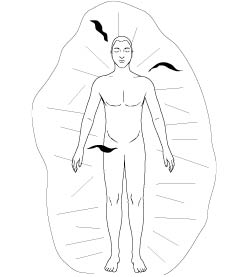
Health Problems Within the Aura
The radiant lines can indicate specific problem areas. The inflammation at the left shoulder and the right hip could reflect pulled or strained muscles. At the head, it could indicate tension and headaches. The asymmetrical radiations can easily reflect poor energy levels, involvement in too many physical activities, poor circulation, and/or other problems.
[1]. In cases such as child abuse, the consciousness literally ejects itself from the body and out of the auric field during the abuse. The more frequently the abuse occurs, the more well formed the hole becomes. Because of this hole and this ejection of consciousness, many individuals do not always remember much of the abuse. Also, the aura will then continually leak energy, and the individual becomes susceptible to a wide range of physical, emotional, and mental imbalances throughout his or her life. This tear in the aura is difficult to heal. Counseling and some of the exercises in the next chapter can assist in sealing the aura. Caution must be used in jumping to conclusions about abuse simply based upon what is seen in the aura. Only someone very well trained should even broach such a subject to someone else, and then only under very controlled, therapeutic circumstances.